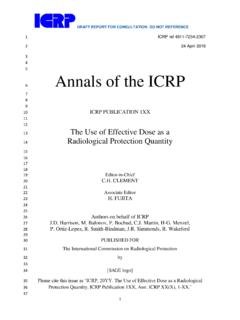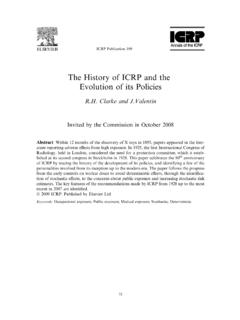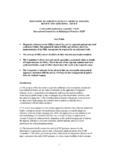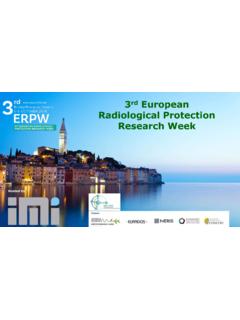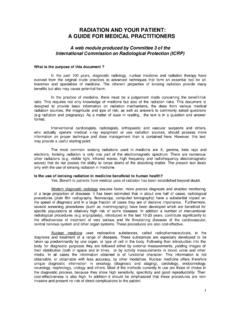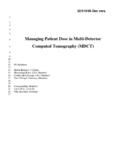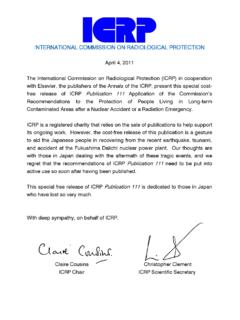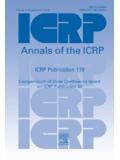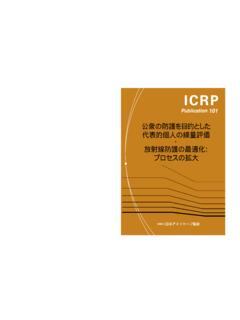Transcription of 22/263/04 RADIATION PROTECTION - ICRP
1 22/263/04 i RADIATION PROTECTION human alimentary tract MODEL FOR RADIOLOGICAL PROTECTION A draft document by a Task Group of Committee 2 of The International Commission on Radiological PROTECTION (29 June - 16 August 2004) DRAFT DOCUMENT Information contained in this document is preliminary and only for internal use by ICRP. This document should not be cited in any published material until final approval by the Commission of ICRP human alimentary tract Model Preface -29 Jun-:5 August 2004 iiCONTENTS Page Preface Glossary 1 The purpose of this report 1 Model used in ICRP Publication 30 2 The need for a new model 3 Model development 5 Structure of the report 6 2.
2 Anatomy and physiology of the alimentary system 11 Introduction 11 General issues 11 Alimentation 13 Vascular supply and drainage 14 Microanatomy of the alimentary tract 15 Epithelia of the alimentary tract 18 3. Absorption, retention and secretion of radionuclides in the human alimentary tract 23 Introduction 23 Radionuclide absorption 24 Radionuclide retention 29 Radionuclide secretion 35 Examples used in this report 37 4. RADIATION effects 53 Introduction 53 Target cells 54 RADIATION -induced cancers in humans 56 Tissue damage 60 5. Description of the human alimentary tract model 67 Introduction 67 Main differences from the ICRP publication 30 model 69 Details of the model structure 70 Radionuclide - specific examples of the use of the model 76 6.
3 Transit times through the alimentary tract 79 Introduction 79 Mouth 80 Oesophagus 82 Stomach 84 Small intestine 87 Colon and rectum 89 Uncertainty and variability 92 7. Morphometry and Dosimetry 103 human alimentary tract Model Preface -29 Jun-:5 August 2004 Introduction 103 Morphometry 103 Dosimetry 115 8. Use of the model 127 Introduction 127 Examples of doses using the HATM 127 Uncertainties 135 Key features of the HATM 142 human alimentary tract Model Preface -29 Jun-:5 August 2004 ivPREFACE A Task Group was appointed by Committee 2 to review the dosimetric model of the gastrointestinal tract used in ICRP Publication 30 (1979) and recommend revisions.
4 The revised model described in this publication is applicable to children as well as adults. The new model will be used in future ICRP publications giving dose coefficients for radionuclide intakes following either occupational or environmental exposures. It will also be used in publications concerned with the interpretation of bioassay measurements. The members of the Task Group were: H. M tivier, (Chairman) D. Melo Bertholon D. Nosske Harrison Phipps Hendry F. Paquet R. Leggett M. Simko Ex-officio members providing advice and ensuring consistency with the work of other Committee 2 Task Groups were: Boecker, Reference Man TG Chairman Stather Internal Dosimetry TG Chairman Eckerman Dose calculations TG Chairman Corresponding members providing advice and reviewing reports drafts were: M.
5 R. Bailey Potten Chen Xing-an Stabin N. Griffiths Stubbs human alimentary tract Model Preface -29 Jun-:5 August 2004 v During this period of preparation of this report, the membership of Committee 2 was: 1997-2000 A. Kaul (Chairman) Boecker Lipzstein A. Bouville H. M tivier Chen Xing-an H. Paretzke G. Dietze A. Eckerman M. Roy Fry Stather, Vice-Chairman J. Inaba Taylor, Secretary Likhtarev T. Wohni 2001-2005 C. Streffer (Chairman) M. Balonov Lipzstein Boecker Menzel A. Bouville H. M tivier G. Dietze H. Paretzke Eckerman Pradhan Fry Stather, Vice-Chairman J. Inaba Taylor, Secretary Likhtarev Y. Zhou human alimentary tract Model Preface -29 Jun-:5 August 2004 vi GLOSSARY OF TERMS This glossary is presented in two parts: the first relates to terms used in radiological PROTECTION and radionuclide dosimetry; the second relates to anatomical and physiological terms.
6 Dosimetry and Biokinetics Absorbed dose the physical dose quantity given by D= d /dm where d is the mean energy imparted by ionising RADIATION to the matter in a volume element and dm is the mass of the matter in the volume element. The SI unit for absorbed dose is joule per kilogram (J kg-1) and its name is gray (Gy). Absorbed Fraction (AF(T S)R) the fraction of energy emitted as a specific RADIATION type R in a specified source region S, which is absorbed in a specified target tissue T. alimentary tract transfer factor fA the alimentary tract transfer factor, fA, is defined as the fraction of activity entering the alimentary tract that is absorbed from the gut in the absence of both radioactive decay losses and endogenous input to the tract .
7 Committed Effective Dose (E( ) the sum of the products of the committed equivalent doses in organs or tissues and the appropriate organ or tissue weighting factors (WT), where is the integration time in years following the intake. The integration time is 50 y for adults and from intake to age 70 y for children. Committed Equivalent Dose (HT( )) the time integral of the equivalent dose rate in a particular tissue or organ that will be received by an individual following intake of radioactive material into the body, where is the integration time in years following the intake. The integration time is 50 y for adults and from intake to age 70 y for children. Dose Coefficient committed equivalent dose in organ or tissue T per unit intake hT( ) or committed effective human alimentary tract Model Preface -29 Jun-:5 August 2004 viidose per unit intake e( ), where is the time period in years over which dose is calculated ( ) 50 y for adults and (70-t0)Y for children.)
8 Note that elsewhere the term "dose pert unit intake(SvBq-1) is used fir dose coefficient. Effective Dose (E) the sum of the weighted equivalent doses in all tissues and organs of the body, given by the expression: E = wTH T T where HT is the equivalent dose in tissue or organ, T, and wT is the weighting factor for tissue T. Equivalent Dose (HT) the equivalent dose, H T,R, in tissue or organ T due to RADIATION R, is given by: H T,R = wR D T,R Where D T,R is the average absorbed dose from RADIATION R in tissue T and wR is the RADIATION weighting factor which is based on the quality of the RADIATION emitted by the source. Since WR is dimensionless, the unit is the same as for absorbed dose, J kg-1, and its name is Sievert (Sv).
9 The total equivalent dose HT, is the sum of H T,R over all RADIATION types H T = H T,R R will be replaced by RADIATION weighing dose Gray (Gy) the special name for the SI unit of absorbed dose: 1 Gy = 1 J kg -1 HATM the ICRP human alimentary tract model HRTM the ICRP human respiratory tract model (ICRP, 1994) Organ Dose the tissue or organ average absorbed dose D T is given by DT = T / mT where T is the total energy imparted in a tissue or organ T and mT is the mass of the tissue or organ. RADIATION weighting factor (wR) the RADIATION weighting factor is a dimensionless factor to derive the equivalent dose from the human alimentary tract Model Preface -29 Jun-:5 August 2004 viiiabsorbed dose averaged over a tissue or organ and is based on the quality of RADIATION and its relative biological effectiveness (ICRP, 1991) SAF specific Absorbed Fraction : Absorbed fraction in a tissue divided by the mass of the tissue Source region (S) region within the body containing the radionuclide.
10 The region may be an organ, a tissue, the contents of the gastrointestinal tract or urinary bladder, or the surfaces of tissues as in the skeleton an the respiratory tract . Specific Effective Energy (SEE(T S)R) the energy, suitably modified by the RADIATION weighting factor, imparted per unit mass of a target tissue , T , as a consequence of the emission of a specified RADIATION , R, from transformations occurring in the source region S expressed as Sv(Bq s) -1. Sievert (Sv) the special name for the SI unit of equivalent dose and effective dose: 1 Sv = 1 J kg -1 Target Tissue tissue or organ in which RADIATION is absorbed Transfer compartment the compartment introduced for mathematical convenience into most of the biokinetic models used in this report to account for the translocation of the radioactive material through the body fluids from where they are deposited in tissues.
